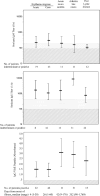Prospective study of serologic tests for lyme disease
- PMID: 18532885
- PMCID: PMC5538270
- DOI: 10.1086/589242
Prospective study of serologic tests for lyme disease
Abstract
Background: Tests to determine serum antibody levels-the 2-tier sonicate immunoglobulin M (IgM) and immunoglobulin G (IgG) enzyme-linked immunosorbent assay (ELISA) and Western blot method or the IgG of the variable major protein-like sequence-expressed (VlsE) sixth invariant region (C6) peptide ELISA method-are the major tests available for support of the diagnosis of Lyme disease. However, these tests have not been assessed prospectively.
Methods: We used these tests prospectively to determine serologic responses in 134 patients with various manifestations of Lyme disease, 89 patients with other illnesses (with or without a history of Lyme disease), and 136 healthy subjects from areas of endemicity and areas in which the infection was not endemic.
Results: With 2-tier tests and the C6 peptide ELISA, only approximately one-third of 76 patients with erythema migrans had results that were positive for IgM or IgG seroreactivity with Borrelia burgdorferi in acute-phase samples. During convalescence, 3-4 weeks later, almost two-thirds of patients had seroreactivity with the spirochete B. burgdorferi. The frequencies of seroreactivity were significantly greater among patients with spirochetal dissemination than they were among those who lacked evidence of disseminated disease. Of the 44 patients with Lyme disease who had neurologic, heart, or joint involvement, all had positive C6 peptide ELISA results, 42 had IgG responses with 2-tier tests, and 2 patients with facial palsy had only IgM responses. However, among the control groups, the IgG Western blot was slightly more specific than the C6 peptide ELISA. The differences between the 2 test systems (2-tier testing and C6 peptide ELISA) with respect to sensitivity and specificity were not statistically significant.
Conclusions: Except in patients with erythema migrans, both test systems were sensitive for support of the diagnosis of Lyme disease. However, with current methods, 2-tier testing was associated with slightly better specificity.
Conflict of interest statement
Figures

Comment in
-
Editorial commentary: laboratory testing for Lyme disease: time for a change?Clin Infect Dis. 2008 Jul 15;47(2):196-7. doi: 10.1086/589316. Clin Infect Dis. 2008. PMID: 18532894 No abstract available.
-
Serologic tests for lyme disease: more smoke and mirrors.Clin Infect Dis. 2008 Oct 15;47(8):1111-2; author reply 1112-3. doi: 10.1086/592121. Clin Infect Dis. 2008. PMID: 18800935 No abstract available.
Similar articles
-
The VlsE (IR6) peptide ELISA in the serodiagnosis of lyme facial paralysis.Otol Neurotol. 2004 Sep;25(5):838-41. doi: 10.1097/00129492-200409000-00031. Otol Neurotol. 2004. PMID: 15354020
-
[Comparison of test with antigen VlsE (C6) with tests with recombinant antigens in patients with Lyme borreliosis].Pol Merkur Lekarski. 2007 Aug;23(134):95-9. Pol Merkur Lekarski. 2007. PMID: 18044336 Polish.
-
Two-tiered antibody testing for Lyme disease with use of 2 enzyme immunoassays, a whole-cell sonicate enzyme immunoassay followed by a VlsE C6 peptide enzyme immunoassay.Clin Infect Dis. 2011 Sep;53(6):541-7. doi: 10.1093/cid/cir464. Clin Infect Dis. 2011. PMID: 21865190
-
More specific bands in the IgG western blot in sera from Scottish patients with suspected Lyme borreliosis.J Clin Pathol. 2010 Aug;63(8):719-21. doi: 10.1136/jcp.2010.076307. Epub 2010 Jun 30. J Clin Pathol. 2010. PMID: 20595179 Review.
-
[Laboratory diagnosis of infection caused by Borrelia burgdorferi].Ugeskr Laeger. 2006 Aug 21;168(34):2805-7. Ugeskr Laeger. 2006. PMID: 16942701 Review. Danish.
Cited by
-
Assessment of antibodies against surface and outer membrane proteins of Anaplasma phagocytophilum in Lyme borreliosis and tick-borne encephalitis paediatric patients.Epidemiol Infect. 2016 Sep;144(12):2597-604. doi: 10.1017/S0950268816000972. Epub 2016 May 16. Epidemiol Infect. 2016. PMID: 27180603 Free PMC article.
-
Proposed Lyme Disease Guidelines and Psychiatric Illnesses.Healthcare (Basel). 2019 Sep 9;7(3):105. doi: 10.3390/healthcare7030105. Healthcare (Basel). 2019. PMID: 31505800 Free PMC article. Review.
-
Case report: persistently seronegative neuroborreliosis in an immunocompromised patient.BMC Infect Dis. 2018 Aug 2;18(1):362. doi: 10.1186/s12879-018-3273-8. BMC Infect Dis. 2018. PMID: 30071836 Free PMC article.
-
Efficient detection of symptomatic and asymptomatic patient samples for Babesia microti and Borrelia burgdorferi infection by multiplex qPCR.PLoS One. 2018 May 10;13(5):e0196748. doi: 10.1371/journal.pone.0196748. eCollection 2018. PLoS One. 2018. PMID: 29746483 Free PMC article.
-
Variants in the Late Cornified Envelope Gene Locus Are Associated With Elevated T-helper 17 Responses in Patients With Postinfectious Lyme Arthritis.J Infect Dis. 2024 Aug 14;230(Supplement_1):S40-S50. doi: 10.1093/infdis/jiae164. J Infect Dis. 2024. PMID: 39140723 Free PMC article.
References
-
- Steere AC. Lyme disease. N Engl J Med. 2001;345:115–25. - PubMed
-
- Recommendations for test performance and interpretation from the Second International Conference on Serologic Diagnosis of Lyme Disease. MMWR Morb Mortal Wkly Rep. 1995;44:590–1. - PubMed
-
- Case definitions for public health surveillance. MMWR Morb Mortal Wkly Rep. 1990;39(RR-13):1–43. - PubMed
Publication types
MeSH terms
Substances
Grants and funding
LinkOut - more resources
Full Text Sources
Other Literature Sources
Medical

